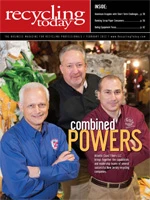 Facility management and every employee that uses a gas cutting torch should review a training document prior to the use of a torch cutting device. Further training may be required or advisable based upon jurisdiction or property and casualty insurance carrier requirements or suggestions.
Facility management and every employee that uses a gas cutting torch should review a training document prior to the use of a torch cutting device. Further training may be required or advisable based upon jurisdiction or property and casualty insurance carrier requirements or suggestions.
A cutting torch is a tool that, if not properly used, could lead to explosion, fire, flash burns, skin burns, eye injury and even loss of life. Some insurance companies have changed their insurance policies so that property damage and loss caused by the use of a cutting torch would lead to a steeply increased deductible in the event of a claim.
Recyclers should retain a signed and dated copy of this and any other training programs in employee files prior to their using a gas cutting torch.
Best Management Practices
Recyclers should consider the following best management practices when using cutting torches. This information should be included in training materials:
- Limit access to torch equipment by locking it up, allowing access only by approval of a supervisor. Only properly orientated employees should use the devices.
- Prior to using the torch, move the vehicle or part to be cut into a “clear zone” that is away from combustibles and other safety hazards.
- All vehicles located in the work area must have the gas tank removed and placed away from the work area. Any fuel spills must be properly cleaned. Confirm floor or soil is dry and free of debris and flammable materials. Many fires are the result of the fuel igniting after the tank has been removed from the vehicle but not cleared from the “clear zone.” Confirm all flammables are removed from the cutting path or near it. Do not take any chances. Sparks from cutting activities can fly up to 35 feet; confirm your zone is clear to that size. Remove all flammable interior and insulation components.
- OSHA eye and face protection standard 29 CFR 1910.133 requires the use of eye and face protection whenever workers may be exposed to hazards such as flying objects, molten metal, liquid chemicals, acids or caustic liquids, chemical gases or vapors or potentially injurious light radiation. Eye protection must conform to the American National Standards Institute (ANSI) Standard Z87.1 – 1989.
- Wear non-flammable gloves and make sure that clothing is worn in such a manner that sparks or slag cannot enter shirts, ignite flammable clothing, burn skin or get trapped in loose or baggy clothing.
- A second employee should observe and be on “fire watch” during all cutting activities. Fire watch must be continued for at least 30 minutes after the cutting has been completed. Do not do any cutting at the end of the day, when no employees will be around to observe the area. After-hours fires are usually the result of a smoldering area that ignites into a fire when no one is there to contain it.
- Know and understand the type and use of each fire extinguisher. Have the proper class of fire extinguisher on hand in the instance a flame or spark comes in contact with flammable materials while using the gas cutting torch. Have the proper fire extinguishers at immediate access during all cutting operations. A further safeguard is the use of rechargeable water extinguishers or garden sprayers that can be used to wet the grounds around the cut area. Water provides an affordable solution for fighting the small fires that can occur with paper and grass that may become ignited.
- The cutting torch is not a hammer. The tip should be free of restriction and properly formed. A damaged tip can lead to improper temperatures and flow that will result in dangerous results and “spitting” of hot molten metal. If the tip is not in good condition, do not use the torch until it is cleaned or replaced.
- Ensure the area is properly ventilated. Ideally, cutting and welding should be conducted outside. Improper ventilation can lead to an oxygen depleted atmosphere, which can lead to suffocation, while an oxygen-rich environment accelerates fire or explosion risk.
- Do not use acetylene at operating pressures above 15 pound-force per square inch gauge (psig), or 103 kilopascals (kPa). This is the maximum working pressure currently permitted by federal regulations.
- Do not handle oxygen regulators, oxygen cylinders, valves or any other equipment with oily or greasy hands or gloves. Oxygen reacts with oil and grease in a manner that could easily result in a fire or explosion.
- Do not use the oxygen to blow dirt off clothing. The fabric can become saturated with oxygen and ignited by spark, flames or cigarettes.
- Do not empty an oxygen cylinder below 25 psig to 50 psig (172 kPa to 345 kPa). When pressure is below this level, the cylinder will lose its positive pressure allowing dangerous contamination to occur.
- Do not smoke when oxygen or fuel gases are present.
- Perform inspections before every use. Look for cracked or damaged hoses and damaged regulators, valves or tips. Look for any contamination with oil or grease. If any damage is reported, do not use the equipment until it is in proper working order.
- Back off the pressure adjusting screw of the regulator to release spring force before opening the cylinder valve.
- Open the cylinder valves very slowly. Opening oxygen valves quickly could result in a violent reaction if contaminants are present.
- You must purge hose lines individually before lighting the torch with the proper flint type device. (Do not use a lighter or matches!) This will assure no oxy-fuel gas mixture is in the hoses, which could cause an explosion or fire when the torch is ignited.
Responsible Parties
The Occupational Safety and Health Administration, 29 CFR 1910.252(a) Fire Prevention and Protection Basic Precautions, and the National Fire Protection Association, 51B Standard for Fire Prevention During Welding, Cutting and Other Hot Work, have established specific requirements for conducting cutting operations. Both standards hold management and supervisors responsible for conducting overall safe cutting operations, providing fire protection equipment and authorizing hot work.
If the torch is used, follow proper guidelines. If proper guidelines are not followed, death, serious injury or devastating property damage could result.
Sue Schauls is an independent environmental consultant with automotive expertise. She is the Iowa Automotive Recyclers executive director and I-CARE program manager and the CCAR-Greenlink technical advisor. She can be contacted through her website at www.SueSchauls.com.

Explore the February 2012 Issue
Check out more from this issue and find your next story to read.
Latest from Recycling Today
- Aqua Metals secures $1.5M loan, reports operational strides
- AF&PA urges veto of NY bill
- Aluminum Association includes recycling among 2025 policy priorities
- AISI applauds waterways spending bill
- Lux Research questions hydrogen’s transportation role
- Sonoco selling thermoformed, flexible packaging business to Toppan for $1.8B
- ReMA offers Superfund informational reports
- Hyster-Yale commits to US production





